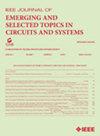A 299–315-GHz Dual-Band Radiator Array With Cascaded Transmission Line-Based Feedback Network for Phase Noise Improvement
IF 3.7
2区 工程技术
Q2 ENGINEERING, ELECTRICAL & ELECTRONIC
IEEE Journal on Emerging and Selected Topics in Circuits and Systems
Pub Date : 2024-01-23
DOI:10.1109/JETCAS.2024.3357612
引用次数: 0
Abstract
This paper presents a THz radiator array integrating two elements, each of which consists of two fundamental oscillators operating at half of the output frequency, a push-push frequency doubler and an on- chip square-shaped loop antenna. To improve the phase noise for the fundamental oscillators, a feedback network containing a long cascaded transmission line featuring high frequency selectivity is proposed. Then, the signal power is extracted through the use of a compact coupled line to drive the doubler, thereby making the integration of a multi-element array more manageable. Furthermore, the strength of the coupling between the two adjacent oscillators within each element is designed properly, yielding dual-band operation to extend the frequency range. Fabricated in a 65-nm bulk CMOS process, the radiator chip assembled with a crystal slab and a silicon lens achieves output frequency ranging from 299.2 to 314.8 GHz. The measured peak effective isotropically radiated power (EIRP) and radiated power are 3.9 and −16.1 dBm, respectively, while consuming 93-mW DC power from a 1.4-V power supply. The phase noise measures −79.9 dBc/Hz at 1-MHz offset from 312 GHz, corresponding to a figure-of-merit (FoM) of 170.1 dBc/Hz. The core area of the chip is基于级联传输线反馈网络的 299-315-GHz 双频辐射器阵列,用于改善相位噪声
本文介绍了一种太赫兹辐射器阵列,该阵列集成了两个元件,每个元件由两个工作频率为输出频率一半的基频振荡器、一个推推倍频器和一个片上方形环形天线组成。为改善基频振荡器的相位噪声,提出了一个反馈网络,其中包含一条具有高频选择性的长级联传输线。然后,通过使用紧凑的耦合线提取信号功率来驱动倍频器,从而使多元件阵列的集成更加易于管理。此外,还对每个元件内相邻两个振荡器之间的耦合强度进行了适当设计,从而实现了双频操作,扩大了频率范围。辐射器芯片采用 65 纳米体 CMOS 工艺制造,与晶体板和硅透镜组装在一起,输出频率范围为 299.2 至 314.8 千兆赫。测得的峰值有效同向辐射功率(EIRP)和辐射功率分别为 3.9 和 -16.1 dBm,而 1.4 V 电源的直流消耗功率为 93 mW。在偏移 312 GHz 1-MHz 时,相位噪声为 -79.9 dBc/Hz,相当于 170.1 dBc/Hz。芯片的核心面积为 0.65 美元乘以 0.21 美元 mm2(不包括焊盘)。
本文章由计算机程序翻译,如有差异,请以英文原文为准。
求助全文
约1分钟内获得全文
求助全文
来源期刊

IEEE Journal on Emerging and Selected Topics in Circuits and Systems
ENGINEERING, ELECTRICAL & ELECTRONIC-
CiteScore
8.50
自引率
2.20%
发文量
86
期刊介绍:
The IEEE Journal on Emerging and Selected Topics in Circuits and Systems is published quarterly and solicits, with particular emphasis on emerging areas, special issues on topics that cover the entire scope of the IEEE Circuits and Systems (CAS) Society, namely the theory, analysis, design, tools, and implementation of circuits and systems, spanning their theoretical foundations, applications, and architectures for signal and information processing.
 求助内容:
求助内容: 应助结果提醒方式:
应助结果提醒方式:


